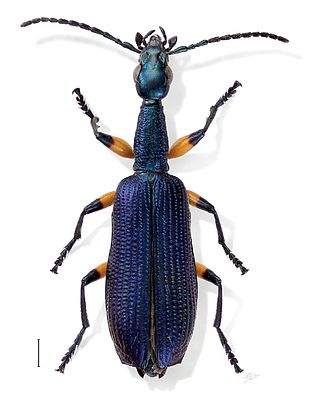
Johann Christoph Friedrich Klug, was a German entomologist. He described the butterflies and some other insects of Upper Egypt and Arabia in Christian Gottfried Ehrenberg and Wilhelm Friedrich Hemprich's Symbolæ Physicæ. He was professor of medicine and entomology in the University of Berlin where he curated the insect collections from 1810 to 1856. At the same time he directed the Botanic Garden in Berlin which contains his collections. Klug worked mainly on Hymenoptera and Coleoptera. The plant genus Klugia was named in his honour as well as the butterflies Geitoneura klugii and Heliophisma klugii.
Gastrotheca testudinea is a species of frog in the family Hemiphractidae. It has a widespread latitudinal range along the eastern (Amazonian) slopes of the Andes of Ecuador, Peru, and Bolivia.

Agra is a genus of beetles in the family Carabidae, the ground beetles. There are over 500 described species, but there are well over 1000 specimens in collections that have not yet been described. The common name elegant canopy beetles has been used for genus Agra.

Omphra is a genus in the beetle family Carabidae. There are about seven described species in Omphra.

Iresia is a genus of beetles in the family Cicindelidae, containing the following species:

Physea is a genus of beetles in the family Carabidae, containing the following species:
Eudromus is a genus in the beetle family Carabidae. There are about six described species in Eudromus, found in Madagascar.
Agathomerus is a genus of beetles in the family Megalopodidae, containing the following species:
Mastostethus is a genus of beetles in the family Megalopodidae, containing the following species:
Megalopus is a genus of beetles in the family Megalopodidae, containing the following species:
Copelatus pulchellus is a species of diving beetle. It is part of the subfamily Copelatinae in the family Dytiscidae. It was described by Johann Christoph Friedrich Klug in 1834.

Phaeoxantha cruciata is a species of tiger beetle in the subfamily Cicindelinae that was described by Brulle in 1837. The species is common in Argentina, Bolivia, Brazil, Paraguay, and Uruguay.

Epicauta is a genus of beetles in the blister beetle family, Meloidae. The genus was first scientifically described in 1834 by Pierre François Marie Auguste Dejean. Epicauta is distributed nearly worldwide, with species native to all continents except Australia and Antarctica. Surveys have found the genus to be particularly diverse in northern Arizona in the United States. Few species occur in the Arctic, with none farther north than the southern edge of the Northwest Territories, Canada.

Hoplocampa is a genus of hymenopteran sawfly in the family Tenthredinidae.
Hoplocampa testudinea, the apple sawfly or European apple sawfly, is a species of sawfly in the family Tenthredinidae. It is native to Europe but has been accidentally introduced into North America where it became invasive. The larvae feed inside the developing fruits of the apple tree.
Phaeoxantha is a genus of tiger beetles in the family Cicindelidae, formerly included within the genus Megacephala.






